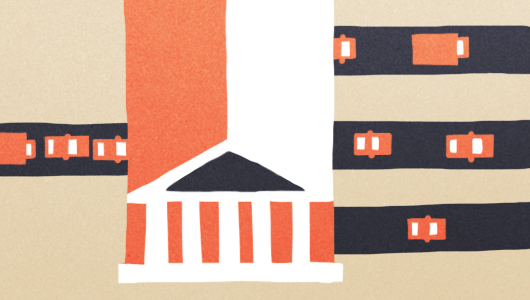➤ What the bill does: (i) Creates the Move NY Highway & Transit Authority (MNYHTA) to own and control the MNYM Fund, and designates the members of the MTA Board serve as the MNYHTA Board.
Read the legislative language: PAL §1279-d(1),(2).
(ii) Directs MNYHTA to disburse all the money in the MNYM Fund, annually, to specified transportation agencies and purposes described in Topic 3, and to publicly report each year on the money going into and out of the MNYM Fund.
Read the legislative language: PAL §1279-d(2).
(iii) Directs NYC-DOT to set up and operate the electronic toll collection and photo-monitoring systems for the new tolls at 60th St. (Topic 1.1) and the East River bridges (Topic 1.2), to create a toll schedule that varies with demand, to decide with TBTA when the new toll plan starts (although the plan cannot start or continue unless TBTA lowers tolls on the 7 MTA bridges), and to transfer all new toll revenue to the MNYM Fund (Topic 2.1) quarterly.
Read the legislative language: VTL §§ 1702, 1703(1), 1703(2), 1703(3), 1703(10), 1705.
(iv) Directs TBTA to lower the tolls on the 7 MTA bridges by certain defined percentages of the Tunnel tolls and maintain the statutory ratios in future toll increases (Topic 1.2)
Read the legislative language: VTL §§ 1703(4), 1703(5), 1703(6).
(iv) Directs the NYC Taxi & Limousine Commission (TLC) to impose and collect the new congestion surcharge on taxis and FHVs, to develop a surcharge schedule that varies with demand (Topic 1.3), and to transfer all surcharge revenue to the MNYM Fund (Topic 2.1) quarterly.
Read the legislative language: VTL §§ 1703(7), 1705.
➤ Rationale: Several agencies share responsibility for transportation in the metro area. The bill coordinates the role of existing City and State agencies, along with the newly created MNYHTA, to create an integrated system of consistent tolls on all vehicles traveling to Manhattan below 60th St., with appropriate adjustments for commercial vehicles, taxis and FHVs.
Each agency that collects new charges is required to transfer the money to the MNYM Fund. TBTA continues to keep revenue collected from the Queens Midtown and Brooklyn Battery Tunnels and the 7 MTA bridges.




Comments0
Commenting is now closed.